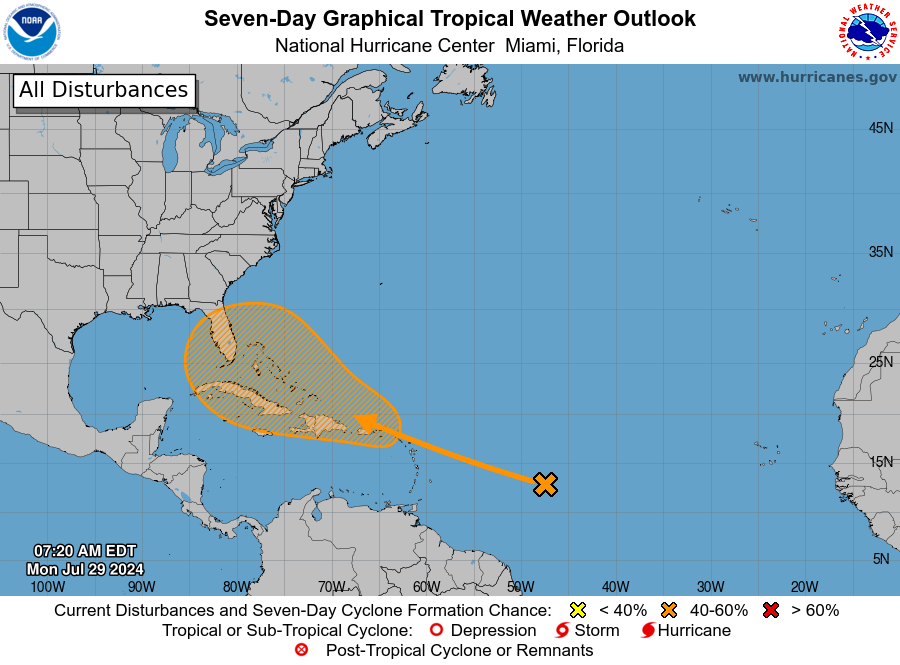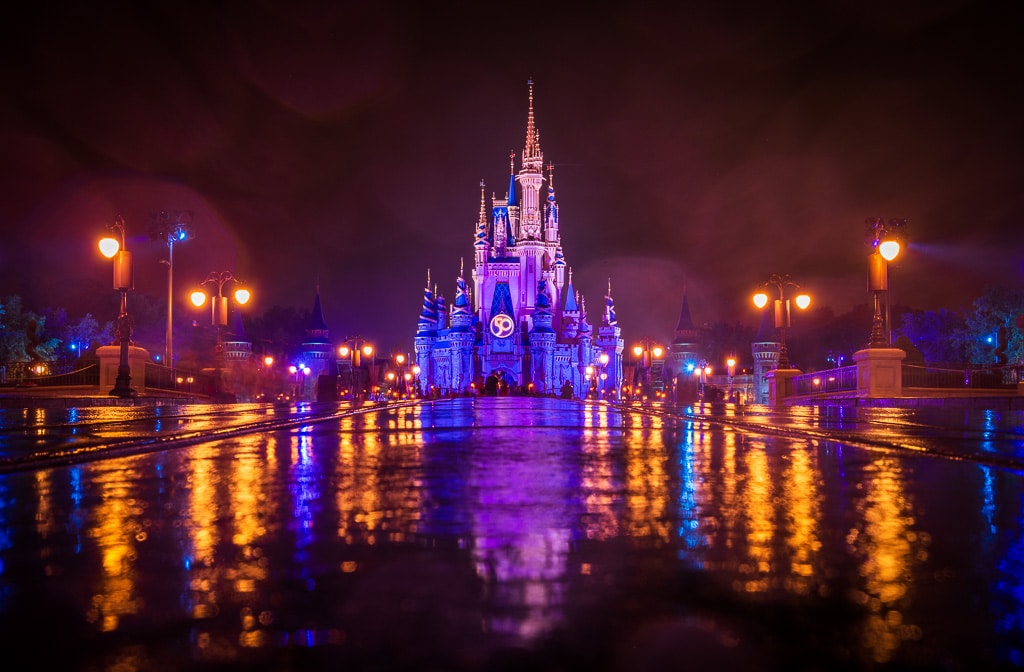
One downside to summer & fall trips to Walt Disney World is tropical storm season. This post covers the 2024 Atlantic hurricane season forecast, tips for staying dry during rain & preparedness info for staying safe during Florida’s intense weather. (Updated July 29, 2024.)
In recent years, Hurricanes Dorian, Matthew, Irma, and Ian have all impacted the parks and resorts to varying degrees–in some cases, causing multi-day closures. This is definitely something to be cognizant of before booking your trip. This isn’t to say you should avoid September or other peak hurricane months, but it’s important to be aware of while weighing the pros and cons of various times to visit.
In an average year, the NOAA forecasts over a dozen named storms. While this is a lot of storms, it’s highly unlikely that any of these will make landfall and subsequently significantly impact Walt Disney World. It’s still uncommon to face park closures due to storms, but it has happened several times. However, even storms hundreds of miles off the coast can make for long, rainy days–rather than the normal afternoon showers that are a fact of life in Florida during the summer and fall.
In other words, if you’re visiting Walt Disney World during the storm season months of June through November 2024, it’s good to be prepared. If you’re visiting between August and October 2024–the heart of hurricane season–it’s also key to have a plan for more major storms.
With that in mind, let’s start with a look at the upcoming Atlantic hurricane season forecast and how it could have an impact on Walt Disney World…
2024 Storm Season News & Updates


It’s been a quiet storm season thus far for Florida, but that could change within the next week. The National Hurricane Center is putting 50/50 odds on an Atlantic system forming into the season’s next tropical storm with a potential path that could bring it to Florida.
As of the NHC’s 2 p.m. update today (July 29, 2024), the area of disturbed weather was located over the central tropical Atlantic, but expected to interact with an approaching tropical wave in the next two days and develop into a storm system as a result. “Environmental conditions are forecast to become conducive for some development thereafter, and a tropical depression could form later this week,” said NHC forecasters.
It’s still way too early to speculate exactly where it may be headed, and models on the system are all over the place because nothing has really formed yet. The window for development is still days away, and once the system develops–if it does at all. According to the NHC, formation chances are near 0% for the next 48 hours but jump to 50% in the next seven days.
If the system were to gain enough strength, it could become Tropical Storm Debby. The 2024 Atlantic hurricane season has had three named storms so far including Hurricane Beryl that cut a deadly path from the Caribbean into Mexico and into Texas.
We’re not trying to be Debbie Downers (get it?!). But rather, we’re bringing this to your attention in case you’re visiting Walt Disney World over the coming weekend or early next week so you can properly prepare. Even if this doesn’t develop into anything that approaches Florida, rain is likely as a result of it. So pack accordingly if you’re visiting Walt Disney World later this week or next. It’s also a good reminder that we’re about to enter the heart of storm season, and this becomes increasingly likely over the next few months.
2024 ATLANTIC HURRICANE SEASON FORECAST
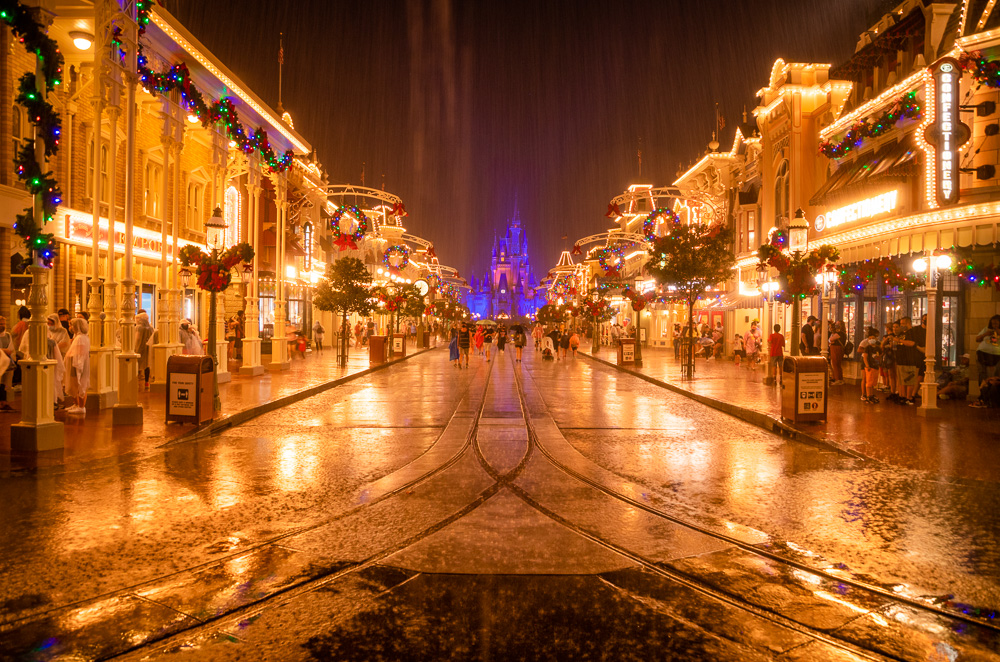

Meteorologists have now released their forecasts for Atlantic hurricane season in 2024. Typically, the Colorado State University Tropical Weather and Climate Research Team, National Oceanic and Atmospheric Administration and National Hurricane Center all release fairly reliable and non-sensationalized forecasts.
This year, the consensus is that this this will be an above-average hurricane season, with an outside chance that it’s a “blockbuster” or “super-charged” season, as all of the ingredients are coming together for explosive tropical development in the Atlantic this year. There are two key factors that have forecasters worried: The return of La Niña and historically warm water across the Atlantic Ocean.
It could be a back-loaded season in 2024, as La Niña might not officially develop until late summer or early autumn. The timing of the onset of La Niña could also dictate whether this upcoming season will be similar to the 2020 season, or if the number of tropical systems will fall short of historic levels.
For its part, NOAA forecasters at the Climate Prediction Center expect above-normal hurricane activity in the Atlantic basin this year. NOAA’s outlook for the 2024 Atlantic hurricane season predicts an 85% chance of an above-normal season, a 10% chance of a near-normal season and a 5% chance of a below-normal season.
NOAA is forecasting a range of 17 to 25 total named storms (winds of 39 mph or higher). Of those, 8 to 13 are forecast to become hurricanes (winds of 74 mph or higher), including 4 to 7 major hurricanes (category 3, 4 or 5; with winds of 111 mph or higher). Forecasters have a 70% confidence in these ranges.
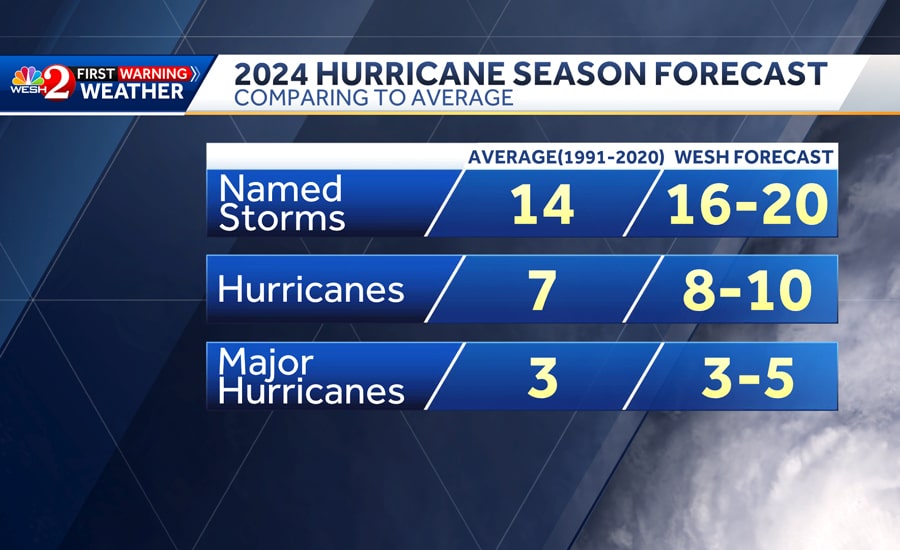

Above is the WESH 2 forecast by local meteorologist Eric Burris. Last year, that team accurately predicted where every named storm went, and when they made landfall. We’ve found that WESH 2 doesn’t sensationalize storm season, and instead presents a facts-first approach. Their past forecasts have often been conservative relative to the consensus. (In general, local reporting by the Orlando and other Florida news stations is really good–better than the national coverage.)
Burris and WESH are predicting 16-20 named storms, 8-10 hurricanes, and 3-5 major hurricanes. WESH also identified potential hotspots for activity, all of which pointed to the eastern Gulf coast. This is particularly concerning for Florida, with Burris adding that not only is Florida under a higher threat for tropical impact, but “perhaps the greatest threat I’ve forecast since beginning these long range outlooks years ago.”
WESH attributes this in large part to the transition from El Niño to La Niña and sea surface temperatures, but goes deeper than that. They also cite Lezak’s Recurring Cycle, a meteorological technique that uses the past to predict the future, to identify long-term weather patterns repeating themselves in cycles. (If you click this WESH link, it goes into detail about specific dates that have the potential for a return of past weather patterns. It’s a fascinating read!)
What follows is the rest of our general advice on visiting Walt Disney World during storm season–and our experience staying at Walt Disney World while the parks closed due to a hurricane…
Our Hurricane Experience
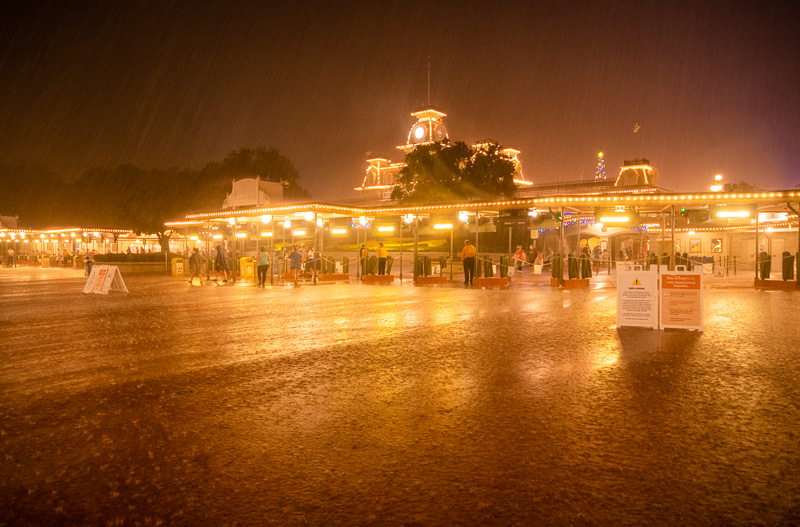

There is ample reason for trepidation if you’re thinking of visiting Walt Disney World in the summer or fall. As Hurricane Dorian, Matthew, and Irma demonstrated, these Atlantic storms have the potential to dramatically alter a vacation. The past is the best predictor of the future, so seeing how Disney dealt with Hurricanes Irma & Matthew could be helpful if you’re concerned about a hurricane impacting your Walt Disney World vacation during storm season.
Hurricane Irma caused Walt Disney World to be closed for two full days and resulted in some damage around the resort. As noted above, we got stuck in Walt Disney World after our Disney Cruise Line Bahamas sailing was canceled (and we were unable to rebook our flight due to the mass exodus of people trying to leave Florida).
You can read about that in Our Hurricane Irma Experience at Walt Disney World, which is like a trip report…but with none of the normal fun stuff, like attractions. It covers what we did to prepare for the storm, how Walt Disney World’s “ride out” Cast Members handled operations, and much more.
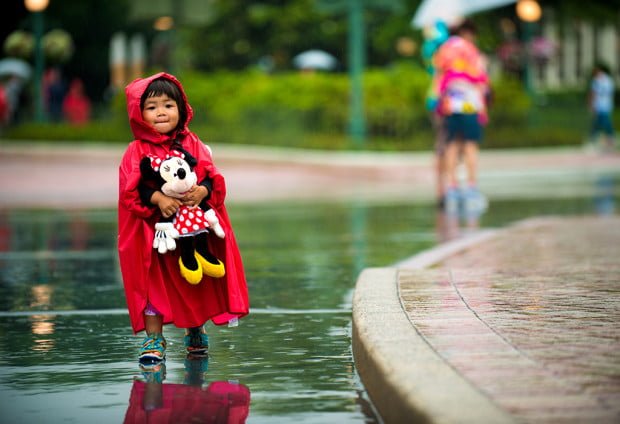

What you need to know for rainy days versus during hurricanes and tropical storms is radically different. With the exception of certain attractions and entertainment that might shut down for regular storms, it’s business as usual for Walt Disney World during the rain. That’s not the case during hurricanes and tropical storms, when operations can be brought to a screeching halt. Luckily, that’s very uncommon.
Although the prospect of visiting during rain or hurricane season might be unsettling, there also is some upside, as you’ll read…so it’s not all bad. Let’s take a look at how to prepare for, and deal with, summer storms at Walt Disney World; from regular small storms to tropical storms to even hurricanes. Let’s start with what you need to know for the worst case scenario…
Hurricane History, Official Policies, Preparedness Tips & Info
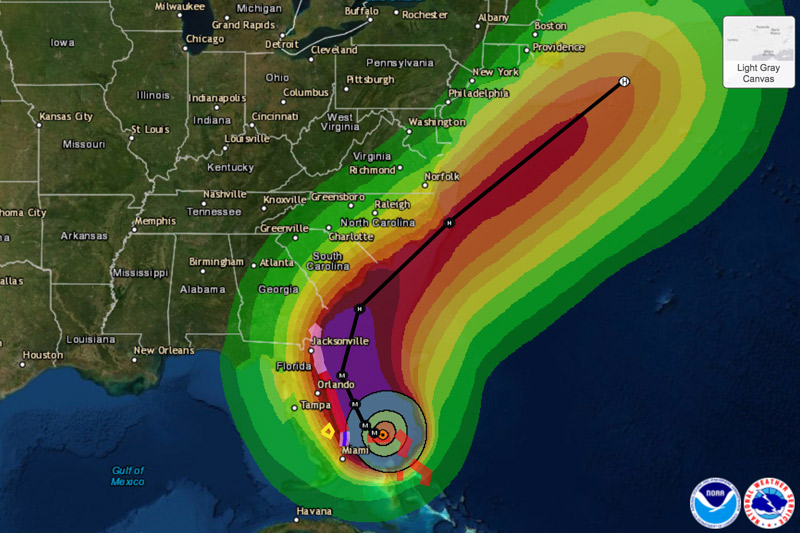

Hurricanes have caused Walt Disney World to close on six occasions. In 1999 for Hurricane Floyd; in 2004 on separate occasions in a six-week span for Hurricanes Frances, Charley, and Jeanne; in 2005 for Hurricane Wilma; in 2016 for Hurricane Matthew; in 2017 for Hurricane Irma; and in 2022 for Hurricane Ian.
That’s an average of about one closure per decade…plus three times in the last decade. There are also several other times when the parks have closed early, or the water parks and certain resorts have closed–but all of that is much more common and not something that’s closely tracked as a result. Suffice to say, the odds are against your trip to Walt Disney World being severely impacted by a hurricane. Nevertheless, storms are becoming increasingly common.
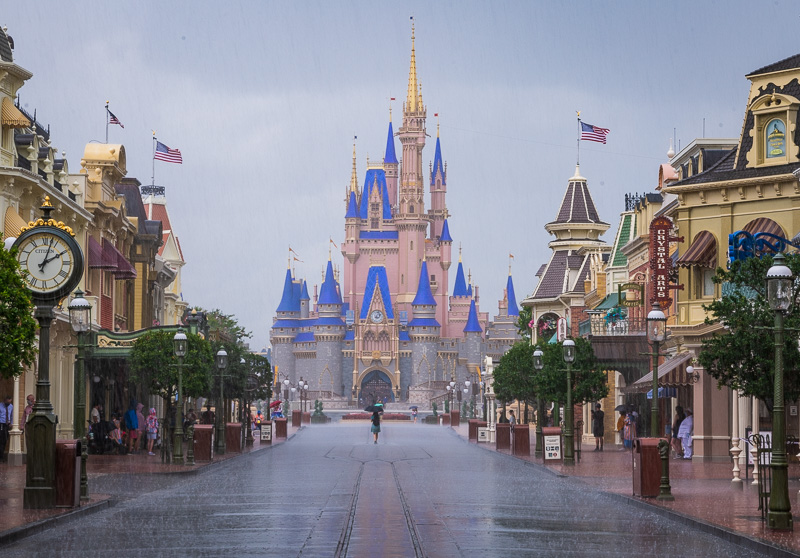

I’ve heard of some travel agents strongly encouraging guests to purchase travel insurance if visiting Walt Disney World in late summer or early fall. I can’t say that I agree with that advice, but then again, I’m not risk averse. We only purchase travel insurance when going abroad, and that’s only in case I get in a fight with a monkey and have to be hospitalized. With that said, here’s what you need to know if a hurricane or tropical storm is forecast during your visit.
Walt Disney World has a Hurricane Policy that will allow you to get a refund on any package booked through Disney. Of course, this won’t cover your airfare. Fortunately, recent storms have caused significant changes in severe storm policies among major airlines, so that shouldn’t be an issue, either. If that leaves any gaps in expenses you’ve paid for, any decent credit card will have you covered.
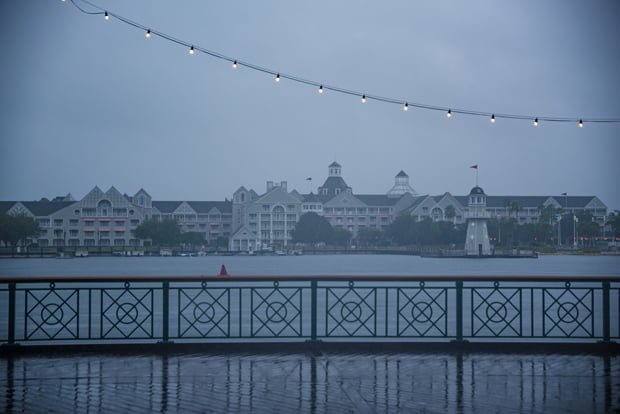

If you normally purchase travel insurance anyway, or you still want travel insurance specifically for hurricane season, make sure you get coverage that actually will do something for you in the event of hurricanes or storms. Most basic policies do not provide coverage for weather, so you’ll want to actually read the policy before you buy. In most cases, you’re going to have to purchase a more expensive policy that allows cancellation for any reason.
Beyond monetary loss, there’s the issue of safety, particularly during hurricanes. In terms of safety, Walt Disney World was built for strict compliance with hurricane readiness standards and has earned “StormReady” status from the NOAA. for this type of thing (regardless of how uncommon they are). In terms of preparedness, Disney is absolutely on the ball.


You literally wouldn’t be able to leave your room without receiving a status update of what’s going on, how operations will be affected, and what to do in case of an emergency. There are also notices up around the resorts and in-room televisions have more information than you’re likely to need on Disney’s channels.
Disney errs on the side of caution with this stuff, and you’d pretty much have to bury your head in the sand to not know what’s going on. You really won’t need anything beyond the information Walt Disney World will provide to you in order to keep safe, but if you want to be especially safe, we recommend reviewing FloridaDisaster.org’s information, including on evacuation routes.
Additionally, we recommend having at least a three-day supply of food, water and medicine on hand. Also, before the storm approaches, ensure cell-phones and other devices are fully charged (including external battery packs) in case of electrical power loss.
Storm Season Packing
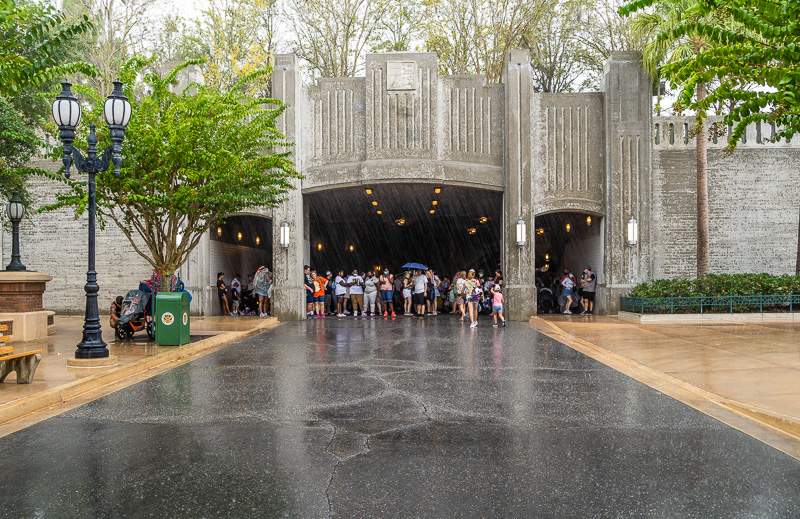

When packing for a trip during storm season, you’ll want to make sure you come prepared in terms of rainwear and footwear. In terms of rainwear, you could pay $79.56 (slight exaggeration–only slight) for a poncho in the parks, or you could bring your own. You should instead get a cheap 10-pack of ponchos that are serviceable before your trip (or two 10-packs, depending upon how many people are in your group).
If you want something more robust that will keep you dry and is reusable, get this 5-Pack of “Pro” Ponchos. While these are technically disposable, they’re a thicker and higher quality material than the ponchos above. We’ve found that they’re easy to reuse–just hang them up to dry in your room at the end of the day! Unless you really want to throw away your ponchos after each use, this is definitely the superior option.
Second, footwear. Nothing is worse than walking miles around Walt Disney World in wet shoes. Trust me. Popular options to avoid this problem are traditional Crocs cogs. Personally, I prefer Crocs sandals because they don’t quite scream “80 year old hospital patient” quite as much. If you’re more serious about your footwear, consider hybrid water/athletic shoes; the best options we’ve found here are the Teva Churn (for men) and RYKA Hydro (for women).
Finally, accessorize with a Frogg Toggs Chilly Pad. This isn’t for the rain itself, but the heat and humidity that come once the rain leaves. Trust me on this once. These things do wonders for cooling you down, and readers of this blog are big fans of them, as can be evidenced by the comments to our Unique Disney Parks Packing List post.
Regular Rain Showers
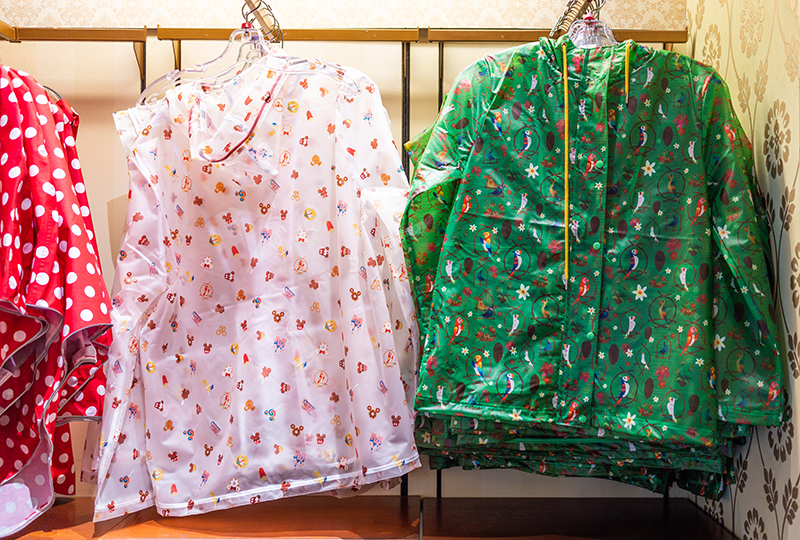

There’s a real-world adage that the only certainties in life are death and taxes. If applied to Walt Disney World, that adage would probably be that the only certainties are a 3 o’clock parade and an afternoon shower. Short afternoon showers are fairly regular in Walt Disney World any time of the year, but during the summer and early fall, they are especially common. Plus, unlike the spring showers that might last for 10 minutes before the sun returns, summer storms can be marathon downpours that don’t relent for a few hours.
The prospect of rain should not keep you out of the parks (let alone from not visiting Walt Disney World during these months), as proper packing will make touring during rainy season a breeze. Plus, the rain will scare plenty of other guests away, so a nice afternoon shower might be just the thing to lower those crowds for you. (Although rain isn’t nearly as effective in Walt Disney World as it is in Disneyland–a light sprinkle there and all of the SoCal locals run for the exits!)
If it’s raining when you get up or the forecast is calling for a lot of rain on a particular day of your trip, we recommend going about your day as you normally would. We know, we know, this flies in the face of the “visit Disney Springs” advice offered by a lot of people, but we disagree with that advice.
To us, going to Disney Springs in the rain instead of a theme park doesn’t make a ton of sense. Besides the huge World of Disney, which is approximately twice the size of Manhattan or something like that, you’re going to spend less time in each shop than you would in a single attraction. This means just as much or more time outdoors in the rain than at a theme park.
If we weren’t going to go to the regular parks, we’d go to the water parks. I mean, why not? You’re going to get wet there anyway, so what’s a little rain? We’ve been to Blizzard Beach when it started raining, and for some reason, the place cleared out! If you don’t want to go to a theme park or a water park, consider your hotel’s pool. If you really, really hate the rain, wander around your resort (have a meal?).
Unless you’re from SoCal and are thus scared of rain, there’s no reason to let the rain completely derail your plans. If it’s raining, lots of other guests won’t be in the parks, so you’ll be able to do more than normal! If you do want to go to the parks, but don’t want to get wet, here are some things to do in the parks while it’s raining to minimize your outdoor exposure.
Magic Kingdom
- Carousel of Progress – Rarely has a line meaning you can ride repeatedly if you’d like.
- Tomorrowland Transit Authority PeopleMover – Lengthy, covered ride that gives you a birds’ eye view of rain status.
- Country Bear Jamboree – Grab a snack or meal at Pecos Bill after, as the attraction dumps you out right there.
- Hall of Presidents – Grab a waffle sandwich or dessert at Sleepy Hollow and take it to the covered seating area after.
- Walt Disney’s Enchanted Tiki Room – Shortest show on this list, but it has a covered pre-show, too.
Epcot
- American Adventure – Another place that can eat an hour when you combine the Voices of Liberty with the show. If it’s still raining after the show ends, go back in to take a look at the art in the lobby gallery.
- The Land Pavilion – In EPCOT, there are several pavilions that are large and indoors. At the front of the park, you have both the Land and Seas pavilions. It’s easy to kill time in the Seas simply by looking at aquatic animals–don’t miss the manatees! Over in the Land, there are three attractions, and you can have a meal at Sunshine Seasons or Garden Grill. If you have a bit of money, the Behind the Seeds at Epcot tour is a GREAT (and relatively inexpensive) way to kill an hour and a half or so, too. Doing all of those things is a good way to kill nearly half a day in one pavilion…which is hopefully enough time for the rain to pass!
- Impressions de France – The same could probably be said for the other World Showcase films, but this is one we can watch again and again; it’s so great that we consider it one of Walt Disney World’s most underrated attractions.
Disney’s Hollywood Studios
- MuppetVision 3D – Awesome pre-show and awesome post-show; consider dining at PizzeRizzo or Mama Melrose after the show to avoid rain.
- Star Wars: Rise of the Resistance – A long line, most of which is indoors, makes this a good option during storms.
- Walt Disney Presents – Possibly the best option in all of Walt Disney World if you’re a serious Disney fan and it’s raining; you could easily spend a few hours in here combing over the displays and watching the film.
Disney’s Animal Kingdom
- Finding Nemo: The Big Blue…and Beyond! – The wait for this musical is outdoors, so show up no more than 10 minutes before a show is scheduled to start; you should have no trouble getting in when it’s raining.
- Festival of the Lion King – A long, indoor show; covered character meet & greets are nearby to kill time, too.
- Avatar Flight of Passage – Not so much a long attraction…but an attraction with a really long, indoor queue. That’ll work!
- ??? – If you can avoid going to Animal Kingdom when it’s raining or a lot of rain is in the forecast, that might be best. It’s definitely most enjoyable in nice weather.
Even after our experience with hurricanes and tropical storms at Walt Disney World, we’d have no hesitation to book trips to Florida in the months of August through October, during the height of potential hurricane or tropical storm season. A good attitude to have when the weather gets bad (or when anything goes wrong, for that matter), is that a rainy day at Walt Disney World is better than a normal day at home. Roll with the punches, improvise, and have a good time. Just think, at the very least…rain makes the parks less crowded.
For where to eat, try out our Walt Disney World Restaurant Reviews page. If you want to save money on tickets or determine which type you should get, read our Tips for Saving Money on Walt Disney World Tickets post. Our What to Pack for Disney Trips post takes a unique look at unconventional things you should take on your trip. Once you arrive at the parks, our Walt Disney World “Ride Guides”are great for determining what to do and when to do it. For overviews of all of these topics and so much more, the best place to start is our comprehensive Walt Disney World Trip Planning Guide to make the most of your experience!
Your Thoughts
Do you agree with our mentality about visiting Walt Disney World when it’s raining? Which activities or attractions do you recommend when it’s raining? How do you feel about the controversial subject of travel insurance? Do you have any questions we can help you answer? Hearing your feedback–even when you disagree with us–is both interesting to us and helpful to other readers, so please share your thoughts below in the comments!

